William W. Howard
Mode Selection and Target Classification in Cognitive Radar Networks
Oct 25, 2023Abstract:Cognitive Radar Networks were proposed by Simon Haykin in 2006 to address problems with large legacy radar implementations - primarily, single-point vulnerabilities and lack of adaptability. This work proposes to leverage the adaptability of cognitive radar networks to trade between active radar observation, which uses high power and risks interception, and passive signal parameter estimation, which uses target emissions to gain side information and lower the power necessary to accurately track multiple targets. The goal of the network is to learn over many target tracks both the characteristics of the targets as well as the optimal action choices for each type of target. In order to select between the available actions, we utilize a multi-armed bandit model, using current class information as prior information. When the active radar action is selected, the node estimates the physical behavior of targets through the radar emissions. When the passive action is selected, the node estimates the radio behavior of targets through passive sensing. Over many target tracks, the network collects the observed behavior of targets and forms clusters of similarly-behaved targets. In this way, the network meta-learns the target class distributions while learning the optimal mode selections for each target class.
Open and Closed-Loop Weight Selection for Pattern Control of Paraboloidal Reflector Antennas with Reconfigurable Rim Scattering
Aug 30, 2023Abstract:It has been demonstrated that modifying the rim scattering of a paraboloidal reflector antenna through the use of reconfigurable elements along the rim facilitates sidelobe modification including cancelling sidelobes. In this work we investigate techniques for determining unit-modulus weights (i.e., weights which modify the phase of the scattered electric field) to accomplish sidelobe cancellation at arbitrary angles from the reflector axis. Specifically, it is shown that despite the large search space and the non-convexity of the cost function, weights can be found with reasonable complexity which provide significant cancellation capability. It is demonstrated that this can be done using open-loop (i.e., with pattern knowledge), closed-loop (without pattern knowledge), or hybrid (with inexact pattern knowledge) techniques. Initially, we examine the use of unconstrained weights. A primary finding is that sufficiently deep nulls are possible with essentially no change in the main lobe with practical (binary or quaternary) phase-only weights. The initial algorithms require a knowledge of the antenna pattern (what we term an ``open-loop'' approach). However, since perfect knowledge of the pattern is not typically available, we also develop closed-loop approaches which require no knowledge of the antenna pattern. It is found that these closed-loop approaches provide similar performance. We demonstrate the time-varying performance of closed-loop approaches by simulating an interfering source which moves across the field of view of the antenna. Finally, we leverage the advantages of both open-loop and closed-loop approaches in a hybrid technique that exploits inexact knowledge of the pattern by seeding a closed-loop optimization with an open-loop solution as its starting point.
Online Learning-based Waveform Selection for Improved Vehicle Recognition in Automotive Radar
Dec 01, 2022Abstract:This paper describes important considerations and challenges associated with online reinforcement-learning based waveform selection for target identification in frequency modulated continuous wave (FMCW) automotive radar systems. We present a novel learning approach based on satisficing Thompson sampling, which quickly identifies a waveform expected to yield satisfactory classification performance. We demonstrate through measurement-level simulations that effective waveform selection strategies can be quickly learned, even in cases where the radar must select from a large catalog of candidate waveforms. The radar learns to adaptively select a bandwidth for appropriate resolution and a slow-time unimodular code for interference mitigation in the scene of interest by optimizing an expected classification metric.
Model Order Estimation in the Presence of multipath Interference using Residual Convolutional Neural Networks
Sep 01, 2022
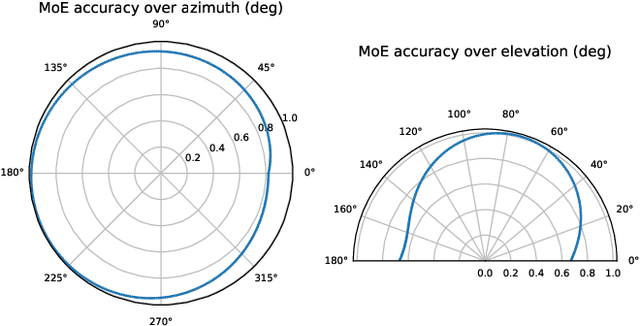
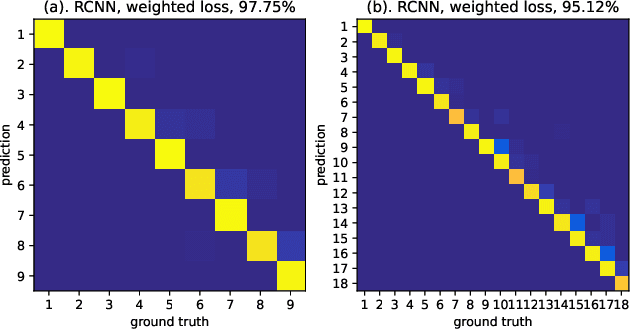
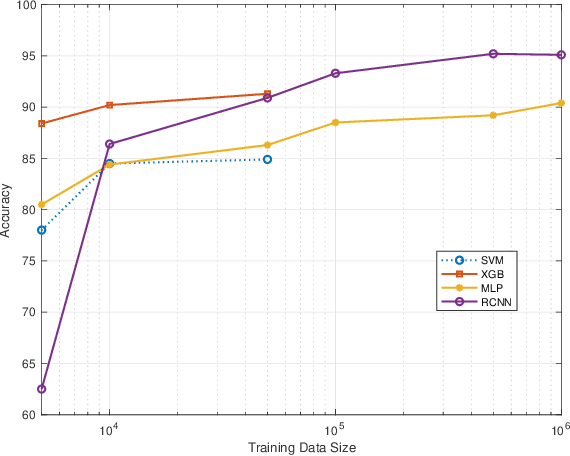
Abstract:Model order estimation (MOE) is often a pre-requisite for Direction of Arrival (DoA) estimation. Due to limits imposed by array geometry, it is typically not possible to estimate spatial parameters for an arbitrary number of sources; an estimate of the signal model is usually required. MOE is the process of selecting the most likely signal model from several candidates. While classic methods fail at MOE in the presence of coherent multipath interference, data-driven supervised learning models can solve this problem. Instead of the classic MLP (Multiple Layer Perceptions) or CNN (Convolutional Neural Networks) architectures, we propose the application of Residual Convolutional Neural Networks (RCNN), with grouped symmetric kernel filters to deliver state-of-art estimation accuracy of up to 95.2\% in the presence of coherent multipath, and a weighted loss function to eliminate underestimation error of the model order. We show the benefit of the approach by demonstrating its impact on an overall signal processing flow that determines the number of total signals received by the array, the number of independent sources, and the association of each of the paths with those sources . Moreover, we show that the proposed estimator provides accurate performance over a variety of array types, can identify the overloaded scenario, and ultimately provides strong DoA estimation and signal association performance.
Adversarial Multi-Player Bandits for Cognitive Radar Networks
Oct 22, 2021



Abstract:We model a radar network as an adversarial bandit problem, where the environment pre-selects reward sequences for each of several actions available to the network. This excludes environments which vary rewards in response to the learner's actions. Adversarial environments include those with third party emitters which enter and exit the environment according to some criteria which does not depend on the radar network. The network consists of several independent radar nodes, which attempt to attain the highest possible SINR in each of many time steps. We show that in such an environment, simple sub-band selection algorithms are unable to consistently attain high SINR. However, through the use of adversarial multi-player bandit algorithms, a radar network can continue to track targets without a loss in tracking precision.
Multi-Target Localization Using Polarization Sensitive Arrays
Aug 18, 2021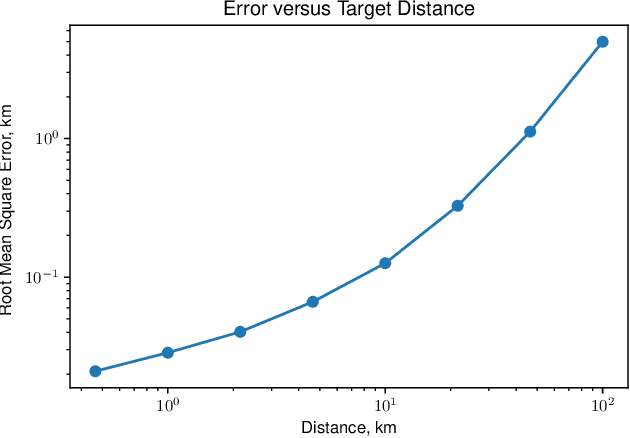

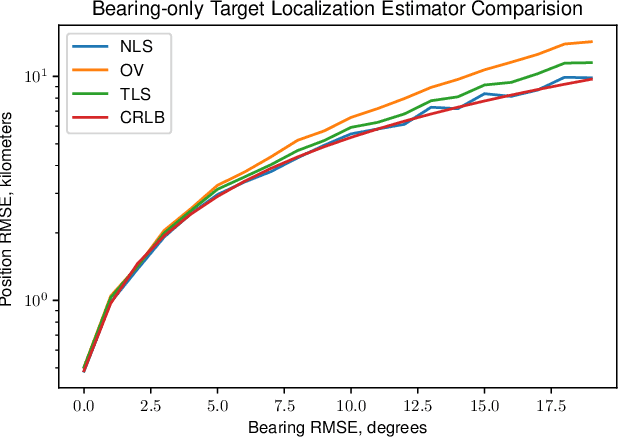

Abstract:In this work we develop clustering techniques for the Bearing Only Target Localization (BOTL) problem. Our scenario has a receiver move along some path, generating bearing estimates on some interval. Multiple emitting targets exist in the environment, and may be physically close with respect to the receiver distance. The first method is iterative and uses only a series of observed bearings to multiple targets to establish clusters. In each iteration, target positions are estimated using a nonlinear least squares solution. The second technique uses additional polarization information, and is shown to be more effective while requiring more information. In addition the second technique is non-iterative and requires far less computation. In this work we presume knowledge of the number of targets. We conclude by providing simulations of our method and show that the proposed approach outperforms previously proposed methods.
Direction of Arrival Estimation for a Vector Sensor Using Deep Neural Networks
Apr 12, 2020



Abstract:A vector sensor, a type of sensor array with six collocated antennas to measure all electromagnetic field components of incident waves, has been shown to be advantageous in estimating the angle of arrival and polarization of the incident sources. While angle estimation with machine learning for linear arrays has been well studied, there has not been a similar solution for the vector sensor. In this paper, we propose neural networks to determine the number of the sources and estimate the angle of arrival of each source, based on the covariance matrix extracted from received data. Also, we provide a solution for matching output angles to corresponding sources and examine the error distributions with this method. The results show that neural networks can achieve reasonably accurate estimation with up to 5 sources, especially if the field-of-view is limited.
 Add to Chrome
Add to Chrome Add to Firefox
Add to Firefox Add to Edge
Add to Edge